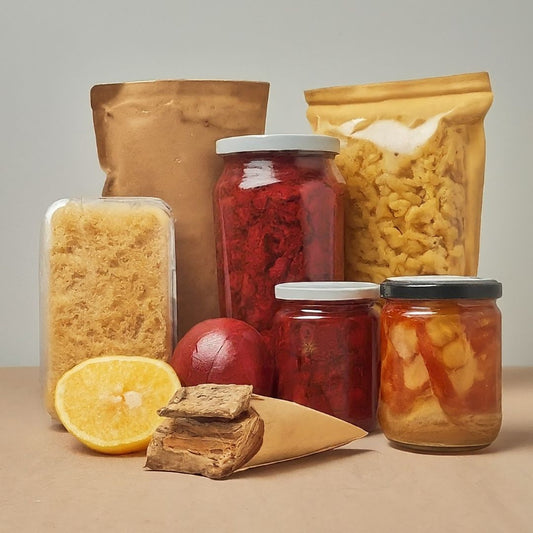Hybrid Food Products
Share
Hybrid Food Products are innovative creations that combine traditional food ingredients or techniques with new technologies or unconventional ingredients to create unique, sustainable, and appealing products. These foods often blend flavors, textures, or nutritional benefits from different sources, appealing to modern consumers seeking novelty, health benefits, and sustainability.
Key Features of Hybrid Food Products
1. Combination of Plant-Based and Animal-Based Ingredients
Merging plant proteins with animal-derived components to improve taste and texture.
2. Technological Integration
Use of advanced food processing technologies like extrusion, precision fermentation, or cultured cells.
3. Sustainability Focus
Utilizing alternative sources to reduce environmental impact while maintaining high nutritional quality.
Real-Time Examples
1. Hybrid Meat Products
Product: Impossible Sausage
Composition: Plant-based protein combined with animal-like heme derived from yeast fermentation.
Purpose: Mimics the texture and flavor of sausage while being eco-friendly.
Product: Tyson’s Raised & Rooted Nuggets
Composition: A blend of plant-based ingredients with chicken.
Benefit: Reduces animal protein usage while providing authentic taste.
2. Dairy-Free and Dairy Combination Beverages
Product: Silk Nextmilk
Composition: Plant-based milk combined with nutrients mimicking the taste and texture of dairy milk.
Use Case: Targets consumers transitioning from dairy to plant-based diets.
3. Cultivated Meat and Plant-Based Hybrids
Product: Future Meat Technologies’ Hybrid Burgers
Composition: Cultured meat blended with plant proteins.
Advantage: Reduces production costs of cultured meat while maintaining a meaty experience.
4. Functional Snacks
Product: KIND Protein Bars
Composition: Plant-based proteins with whey for enhanced nutrition.
Impact: A high-protein, convenient snack with balanced taste and sustainability.
5. Seafood Hybrids
Product: Blended Tuna by Good Catch
Composition: Combines plant proteins with sustainably caught tuna.
Purpose: Lowers the environmental impact of seafood harvesting while delivering similar taste and texture.
6. Dessert Innovations
Product: Oatly Ice Cream
Composition: Oat-based ingredients blended with creamy emulsifiers for a dairy-like texture.
Target Audience: Lactose-intolerant or vegan consumers.
7. Hybrid Bakery Products
Product: Croissant-Doughnut (Cronut)
Composition: Combines the flaky layers of a croissant with the fried texture of a doughnut.
Consumer Appeal: Novelty and indulgence.
Advantages of Hybrid Food Products
Nutritional Customization: Tailored to meet specific health needs (e.g., protein, fiber).
Eco-Friendly: Reduces reliance on traditional animal farming.
Cultural Fusion: Offers new flavors by blending elements from different cuisines.
Innovation Appeal: Attracts consumers looking for something unique and exciting.
Challenges
Cost: Advanced technology can make these products more expensive initially.
Consumer Acceptance: Education is needed to overcome skepticism about new food sources.
Regulation: New ingredients or processes often require rigorous approval.
Key Features of Hybrid Food Products
1. Combination of Plant-Based and Animal-Based Ingredients
Merging plant proteins with animal-derived components to improve taste and texture.
2. Technological Integration
Use of advanced food processing technologies like extrusion, precision fermentation, or cultured cells.
3. Sustainability Focus
Utilizing alternative sources to reduce environmental impact while maintaining high nutritional quality.
Real-Time Examples
1. Hybrid Meat Products
Product: Impossible Sausage
Composition: Plant-based protein combined with animal-like heme derived from yeast fermentation.
Purpose: Mimics the texture and flavor of sausage while being eco-friendly.
Product: Tyson’s Raised & Rooted Nuggets
Composition: A blend of plant-based ingredients with chicken.
Benefit: Reduces animal protein usage while providing authentic taste.
2. Dairy-Free and Dairy Combination Beverages
Product: Silk Nextmilk
Composition: Plant-based milk combined with nutrients mimicking the taste and texture of dairy milk.
Use Case: Targets consumers transitioning from dairy to plant-based diets.
3. Cultivated Meat and Plant-Based Hybrids
Product: Future Meat Technologies’ Hybrid Burgers
Composition: Cultured meat blended with plant proteins.
Advantage: Reduces production costs of cultured meat while maintaining a meaty experience.
4. Functional Snacks
Product: KIND Protein Bars
Composition: Plant-based proteins with whey for enhanced nutrition.
Impact: A high-protein, convenient snack with balanced taste and sustainability.
5. Seafood Hybrids
Product: Blended Tuna by Good Catch
Composition: Combines plant proteins with sustainably caught tuna.
Purpose: Lowers the environmental impact of seafood harvesting while delivering similar taste and texture.
6. Dessert Innovations
Product: Oatly Ice Cream
Composition: Oat-based ingredients blended with creamy emulsifiers for a dairy-like texture.
Target Audience: Lactose-intolerant or vegan consumers.
7. Hybrid Bakery Products
Product: Croissant-Doughnut (Cronut)
Composition: Combines the flaky layers of a croissant with the fried texture of a doughnut.
Consumer Appeal: Novelty and indulgence.
Advantages of Hybrid Food Products
Nutritional Customization: Tailored to meet specific health needs (e.g., protein, fiber).
Eco-Friendly: Reduces reliance on traditional animal farming.
Cultural Fusion: Offers new flavors by blending elements from different cuisines.
Innovation Appeal: Attracts consumers looking for something unique and exciting.
Challenges
Cost: Advanced technology can make these products more expensive initially.
Consumer Acceptance: Education is needed to overcome skepticism about new food sources.
Regulation: New ingredients or processes often require rigorous approval.





